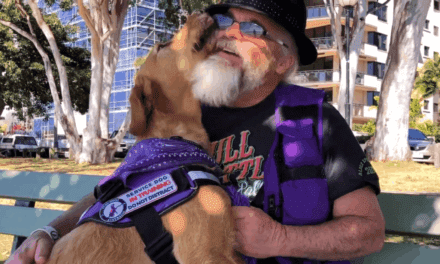Ryan Jones lives in Adelaide with his partner, Sam Castle and a Malamute epileptic dog called Atari.
A couple of years ago, without warning Atari had a seizure, he was shaking, frothing at the mouth and stiff. At the time of Atari’s first seizure, Ryan and Sam had no idea what was really happening to their beloved dog. Their vet was not surprised, however. They found out the hard way that Malamutes were prone to epilepsy and the condition is likely to present at around two years old.
Discovering Atari had epilepsy and managing his condition was a big learning curve for Ryan and Sam. They want to help other dog owners by sharing their experience of living with a Malamute epileptic dog. They have three great tips to help you prepare for seizures and manage the condition.
Pets4Life: Tell us about Atari, what does he love getting up to?
Ryan: Atari is half Husky, quarter Labrador and quarter Samoyed. As a result, he looks kind of like a fluffy Labrador with a curly, bushy Samoyed tail. His coat gets grey/white in winter, and in summer he’s a white/golden brown mix. He recently had his fourth birthday!
Atari is a dog with a great personality. He has his little quirks and processes. He loves…food, cuddles, walks, head scratches, playing with other dogs, fetching and destroying soft drink bottles (but is terrible at giving them back), and drives in the car, especially when he recognises where we are heading.
Pets4Life: When did you discover Atari had epilepsy? It must have been frightening not knowing what was happening.
Ryan: Atari was 2 when he was diagnosed with epilepsy. I was sitting on the couch playing video games, and he’d decided to squeeze in behind me on the couch. At first, I thought he was just doing his usual trick of stretching out and pushing into my back, but when I went to touch him, I realised he was shaking and stiff. Not knowing what was happening, I picked him up and put him on the floor, while he was shaking, frothing at the mouth and stiff.
After what seemed like an eternity it [seizure] started to subside, and when I was trying to pat him he tried to bite me, which we later discovered was because of his disorientation – he had lost control of his body during his fit, lost his eyesight, hearing and bladder control temporarily, and he’d never usually bite. So I backed off and called him to me, and walked him outside and around in circles for a bit to see how he was, while my partner Sam called the vet. It was pretty scary stuff, and I was thinking we’d broken the dog! He was always up to date on his shots and vet visits so we weren’t sure what was going on.
The vet was absolutely brilliant, Atari spent the day there under observation and had no fits. But after taking him home he had another 3-4 fits. Again, the next day the vet kept him under observation and he didn’t have any more fits. This time though they put him on tablets, something they apparently avoid with dogs that have infrequent fits.
Pets4Life: How do you manage Atari’s epilepsy on a daily basis?
Ryan: The vet put Atari on Phenomav, and he takes 2 tablets morning and night before his breakfast/dinner. He also has to visit the vet every 6 months to have a blood test – this confirms he has enough of the Phenomav in his system to prevent further fits. Since he went onto this drug he hasn’t had any seizures but is being monitored and managed by the vet.
We made sure the drugs were positively associated with Atari’s meal times. So when he used to listen for the cue “Breakfast”, or “Dinner”, now he responds to “Drugs?”, and is quite happy to sit there and we then hand feed the tablets to him.
Pets4Life: Any tips for families who may see seizures in their dog?
Ryan: My first tip – get a decent vet! Our vet at Blakes Crossing Veterinary Surgery was great. When Atari first had a fit – they fit us straight in, looked after him, and went out of their way to keep our costs down. Ongoing, Atari usually sees Dr Georgie who is always happy to see him and has done a great job of monitoring him.
The second tip – make sure you’re aware of the side effects of the drugs. We have learnt about 2 side effects over time about Phenomav. It includes an anaesthetic, so Atari tires easily. He loves his walks but spends a lot of his time napping. It also affects Atari’s appetite, he gets hungry easily, and so as a result seems quite desperate for food. This has no impact on his weight as we keep him to the strict amounts of dog food the vet recommends, but when we have visitors over it often looks like we don’t feed him!
The last tip – don’t stress too much if or when your dog has its first seizure. Once we visited the vet, they were not surprised at all. With Atari’s breed, it was a strong possibility epilepsy could present at his age. If we’d known that in advance we wouldn’t have stressed out so much!







